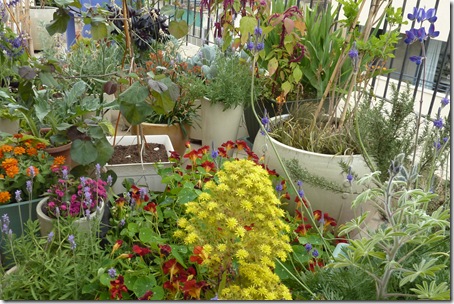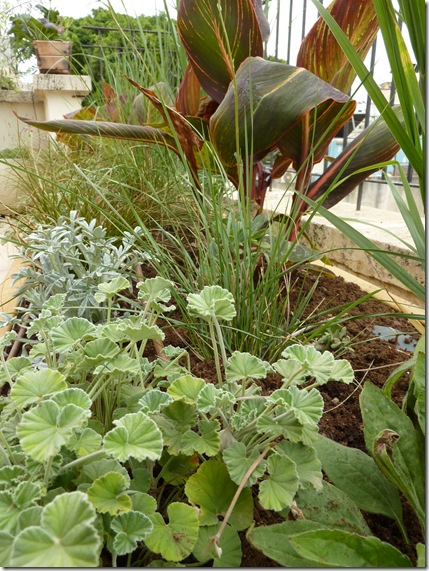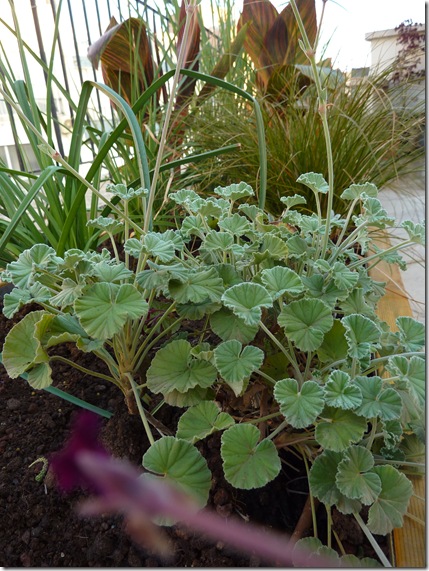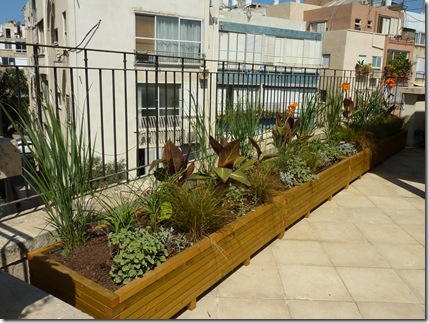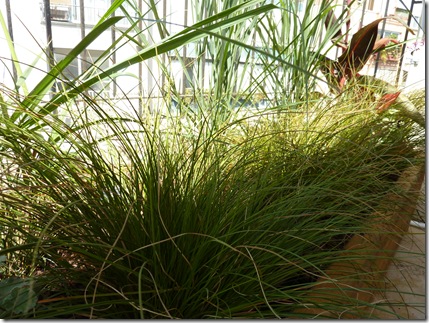After 2 years of experimenting, researching, and trying to find someone who could help implement my ideas, i FINALLY finished and planted the first phase of my front garden.
Any of you who have been following my garden making in Israel know that I am someone who can live with ambivalence. Not rushing to decision allows me to meander and play with new ideas.
I tried a container garden (and hand watering) last summer. I knew it had to go. I desperately wanted to have a garden where I could sink my hands into the dirt, push the soil around, and have dirty fingernails.
After more frustration than I’ve experienced in a long time, I was introduced to a designer who understood what I wanted and worked with me to create it.
It’s a simple design….4 beautifully crafted raised beds side by side next to the front balustrade….a good length (132”) but with a narrow width, a measly 22”.
I’m used to designing gardens that are minimally 4’ deep. My style is one of several of one perennial in large numbers sweeping throughout the bed. This was going to be a challenge.
Why I assumed that I would be able to use at least 3 of one perennial in a grouping is beyond any logic. Once the wooden structures were brought up and positioned on the rooftop, it finally hit me that the width of my planting space could be problematic.
After a moment of a ‘OMG, what did I do?’, I realized that designing an ornamental grass garden was solution. I was going to take a disciplined approach…something that wasn’t going to be easy for me.
It was no problem finding 3 ornamental grasses that would work perfectly. The first one, Panicum ‘Northwind’ is a Roy Diblik introduction straight from his nursery, Northwind Perennial Farm in Wisconsin. It looks like it’s going to be a winner. The native Muhlenbergia capilaris, with its fluffy pink seed heads was perfect as a mid-border grass. As much as I wanted to go native, I couldn’t resist Carex ‘Prairie Fire’ from New Zealand. Its bronzed tinge leaves that turn burnt orange in the fall are breathtaking.The native Carex pennsylvanica wasn’t going to cut it.
I should have stopped there. But I couldn’t resist. I wanted to try Rudbeckia deemii, a native rudbeckia that with which I wasn’t familiar. My eyes landed on dozens of orange kniphofias. Couple that with the Canna tropicana from last year and I’ve got a winner.
‘OK….enough’ I told myself.’ But then I was drawn to a sweet, deep purple silver leaved plant that reminded me of Geranium ‘phaeum’ which I love. It was Pelargonium ‘sidoides’. It would look magnificent sidled up against the carex. I quickly packed 9 of them in a box before I could change my mind.
I’m sure you’ve experienced the same ‘gotta have it/can’t resist’ impulse. And the more you garden, the more difficult it is to resist buying ‘just one more plant….or two or three.’ Before you know it, you’ve become a plantaholic.
I knew I was going to have a blast planting the garden up….and I did. When I finished, It looked sparse but I was used to that. It didn’t bother me at all. By fall, it would begin to fill out with texture, movement, color, and wildlife.
Within a few days, my pleasure turned to discomfort. The garden just didn’t feel right. Why hadn’t I followed my original plan of an ornamental grass garden? It was back to the drawing board.
Another round of Panicum, Carex, and Muhlenbergia landed on my rooftop yesterday afternoon.
I started removing perennials and planting new ones this morning. How does it look? Too soon to tell. What am I going to do with the perennials that I pulled out? What does any keen gardener do? Tell us what you do in this situation.
5 WAYS TO KNOW IF YOU’RE A PLANTAHOLIC
1. Your pupils dilate, you gasp for breath, and sweat profusely when you lay eyes on a plant you’ve seen for the first time.
2. You don’t flinch when the cashier tells you how much you owe….even though it’s way over your budget. ‘Eh’, you think to yourself ‘buying tons of plants is better than gambling.’
3. You transplant the majority of your ‘must have/can’t resist’ plants to a holding bed by fall. They just don’t work well in the garden. ‘No problem’, you think, ‘I’ll find another place for them’.
4. You pat yourself on the back for experimenting, learning, and taking risks. ‘Yes, it cost some extra bucks,’ you tell yourself ‘ but it’s a lot cheaper than studying horticulture at a university. And look how much I learned.’
5. You do the exact same thing the following year….even though you promised yourself that you wouldn’t.
Do you consider yourself to be a plantaholic? If so, share your stories with us.

